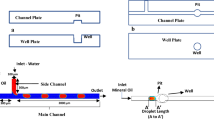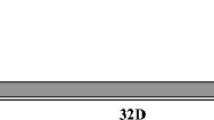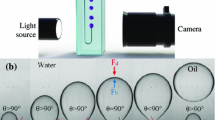Abstract
Micro-droplet formation from an aperture with a diameter of micrometers is numerically investigated under the cross-flow conditions of an experimental microchannel emulsification process. The process involves dispersing an oil phase into continuous phase fluid through a microchannel wall made of apertured substrate. Cross-flow in the microchannel is of non-Newtonian nature, which is included in the simulations. Micro-droplets of diameter 0.76–30 μm are obtained from the simulations for the apertures of diameter 0.1–10.0 μm. The simulation results show that rheology of the bulk liquid flow greatly affects the formation and size of droplets and that dispersed micro-droplets are formed by two different breakup mechanisms: in dripping regime and in jetting regime characterized by capillary number Ca. Relations between droplet size, aperture opening size, interfacial tension, bulk flow rheology, and disperse phase flow rate are discussed based on the simulation and the experimental results. Data and models from literature on membrane emulsification and T-junction droplet formation processes are discussed and compared with the present results. Detailed force balance models are discussed. Scaling factor for predicting droplet size is suggested.




















Similar content being viewed by others
References
Abrahamse AJ, van der Padt A, Boom RM, de Heij WBC (2001) Process fundamentals of membrane emulsification: simulation with CFD. AIChE J 47(6):1285–1291
Brackbill JU, Kothe DB, Zemach C (1992) A continuum method for modeling surface tension. J Comput Phys 100:335–354
Charcosset C, Limayem I, Fessi H (2004) The membrane emulsification process—a review. J Chem Technol Biotechnol 79:209–218
Fluent User’s Guide (2005) Fluent documentation 6.2. NH, Lebanon. Available at: http://www.fluent.com
Friberg SE, Larsson K (1997) Food emulsions. Marcel Dekker Inc, New York
Gijsbertsen-Abrahamse AJ, van der Padt A, Boom RM (2004) Status of cross-flow membrane emulsification and outlook for industrial application. J Membr Sci 230(2004):149–159
Harvie DJE, Davidson MR, Cooper-White JJ (2005) A parametric study of droplet deformation through a microfluidic contraction. ANIAM J 46(E):C150–C166
Husny J, Cooper-White JJ (2006) The effect of elasticity on drop creation in T-shaped microchannels. J Non-Newtonian Fluid Mech 137:121–136
Izumida Y, Sugiura S, Oda T, Satake M, Nakajima M (2005) Production of Quasi-monodisperse emulsion with large droplets using a micromachined device. J Am Oil Chem Soc 82(1):73–78
Katoh R, Asano Y, Furuya A, Sotoyama K, Tomita M (1996) Preparation of food emulsion using a membrane emulsification system. J Memb Sci 113:131–135
Kobayashi I, Yasuno M, Iwamoto S, Shono A, Satoh K, Nakajima M (2002) Microscopic observation of emulsion droplet formation from a polycarbonate membrane. Colloids Surf A Physicochem Eng Asp 207:185–196
Koo S, Sangani AS (2002) Effective-medium theories for predicting hydrodynamic transport properties of bidisperse suspensions. Phys Fluids 14(10):3522–3533
Mason TG, Bibette J (1996) Emulsification in viscoelastic media. Phys Rev Lett 77(16):3481–3484
Peng S, Williams RA (1998a) Controlled production of emulsion using cross flow membrane. Part Part Syst Charact 15:21–25
Peng S, Williams RA (1998b) Controlled production of emulsion using cross flow membrane. Part I. Droplet formation from a single pore. Trans IChemE 76(A8):894–901
Sang L, Hong Y, Wang F (2009) Investigation of viscosity effect on droplet formation in T-shaped microchannels by numerical and analytical methods. Microfluid Nanofluid 6:621–635
Schröder V, Behrend O, Schubert H (1998) Effect of dynamic interfacial tension on the emulsification process using microporous, ceramic membranes. J Colloid Interface Sci 202:334–340
Silva L, Tonkovich AL, Qiu D, Neagle P, Pagnatto K, Perry S, Lochhead R (2005) Enabling advanced emulsions in microchannel architecture. Cosmet Toiletries 120(8):41–46
Steegmans MLJ, Schroen KGPH, Boom RM (2009) Characterization of emulsification at flat microchannel. Y Junction. Langmuir 25:3396–3401
Teipel U (2002) Influence of droplet size on the rheological behavior of emulsions. Chem Eng Technol 25(6):609–615
Tice JD, Lyon AD, Ismagilov RF (2004) Effects of viscosity on droplet formation and mixing in microfluidic channels. Anal Chim Acta 507(1):73–77
Tong J, Nakajima M, Nabetani H (2002) Preparation of phospholipid oil-in-water microspheres by microchannel emulsification technique. Eur J Lipid Sci Technol 104:216–221
Utada AS, Fernandez-Nieves A, Stone HA, Weitz DA (2007) Dripping to jetting transitions in coflowing liquid streams. Phys Rev Lett 99(9):094502
Vladisavljevic GT, Schubert H (2002) Preparation and analysis of water-in-oil emulsions with a narrow droplet size distribution using Shirasu-porous-glass (SPG) membrane. Desalination 144:167–172
Xu JH, Li SW, Tan J, Luo GS (2008) Correlations of droplet formation in T-junction microfluidic device: from squeezing to dripping. Microfluid Nanofluid 5:711–717
Acknowledgments
Authors would like to acknowledge the anonymous reviewers for their insights and valuable suggestions.
Author information
Authors and Affiliations
Corresponding author
Rights and permissions
About this article
Cite this article
Qiu, D., Silva, L., Tonkovich, A.L. et al. Micro-droplet formation in non-Newtonian fluid in a microchannel. Microfluid Nanofluid 8, 531–548 (2010). https://doi.org/10.1007/s10404-009-0487-5
Received:
Accepted:
Published:
Issue Date:
DOI: https://doi.org/10.1007/s10404-009-0487-5




